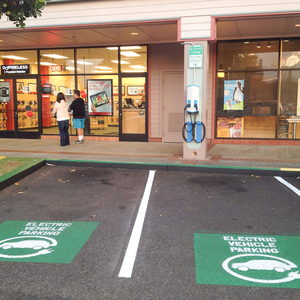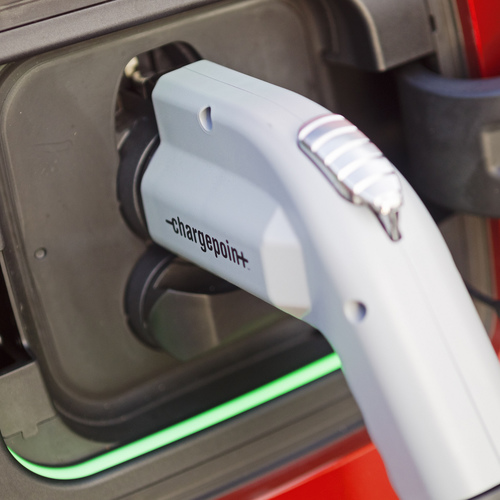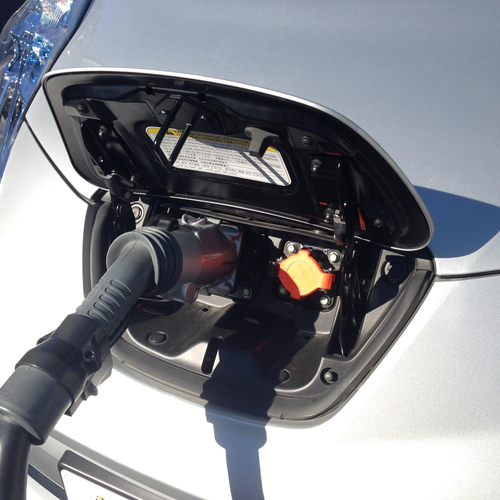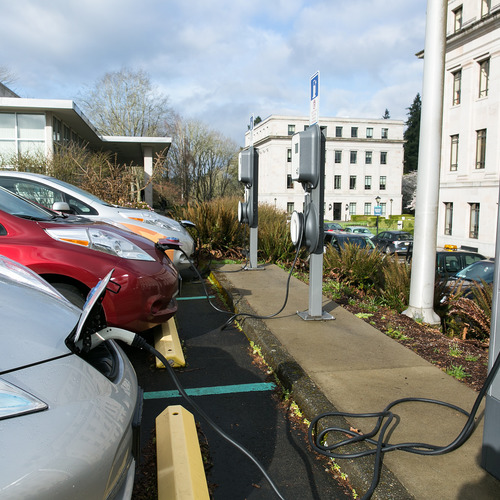
Replacing petroleum fuels with electricity is crucial for curbing climate change because it cuts carbon dioxide emissions from transportation—the largest source of U.S. global warming emissions and a growing source worldwide. Even including the impacts of generating electricity to run them, electric vehicles provide clear environmental benefits.
Plug-in vehicles are making great progress, with their share of U.S. car and light truck sales jumping from 2% to 4% in 2020-2021 and projected to exceed 6% by the end of 2022. But sales of gas-guzzling pickups and SUVs are also surging. This other face of the market subverts electric cars’ carbon-cutting progress.
As a researcher who studies transportation and climate change, it’s clear to me that EVs provide large carbon reductions that will grow as the electric grid shifts to carbon-free energy. But fleetwide emissions, including vehicles of all types and ages, are what ultimately matters for the climate.
While the latest policy advances will speed the transition to EVs, actual emission reductions could be hastened by tightening greenhouse gas emissions standards, especially for the larger gasoline-powered personal trucks that dominate transportation’s carbon footprint. Because it takes 20 years to largely replace the on-road automobile fleet, gas vehicles bought today will still be driving and emitting carbon dioxide in 2040 and beyond.
Public policy progress
Plugging in rather than pumping gas reduces both global warming and smog-forming pollution. It avoids the ecological harm of petroleum production and reduces the economic and security risks of a world oil market coupled to totalitarian regimes such as those of Russia and in the Middle East.
On the good news front, automakers are offering ever more EV choices and promising all-electric fleets within 15 years or so. Two recent policy developments will help turn such promises into reality.
One is California’s recent update to its zero-emission vehicle program. The new regulations will require that by 2035, 100% of new light vehicles sold in California must be qualifying zero-emission vehicles, allowing for a limited number of plug-in hybrid vehicles. Other states that historically have adopted California’s emission standards may follow its lead, so cars running only on gasoline could ultimately be banned across 40% of the U.S. new car market.
In addition, the Inflation Reduction Act recently signed by President Biden includes new incentives for EVs and subsidies for domestic production of EVs, batteries and critical minerals. The new policy targets incentives in several ways, disqualifying high-income consumers, capping the price of qualifying vehicles, providing incentives for used EVs, and restricting the tax credits to EVs built in the U.S. and Canada. It complements the $7.5 billion for building a national EV charging network authorized by the infrastructure bill that the Biden administration brokered in 2021.
The consumption conundrum
In spite of rapidly growing sales, however, EVs have not yet measurably cut carbon. Environmental Protection Agency data indicates that the rate of carbon dioxide reduction from new vehicles has all but stalled, while vehicle mass and power have reached all-time highs.
Why? The surging popularity of low-fuel-economy pickups and SUVs. My analysis of the EPA data shows that through 2021, the higher emissions from market shifts to larger, more powerful vehicles swamp the potential carbon dioxide reductions from EVs by more than a factor of three.
Including the largest personal pickup trucks, which are omitted from the EPA’s public data, would further increase the gasoline vehicle emissions that overwhelm EV carbon reductions. Because vehicles remain on the road for so long, excessive emissions from popular but under-regulated pickups and SUVs will harm the climate for many years.
Complications of clean-car rules
A reason for this conundrum is that clean-car standards are averaged across the overall fleets of cars and light trucks that automakers sell. When a manufacturer increases its sales of EVs and other high-efficiency vehicles, it can sell a greater number of less fuel-efficient vehicles while still meeting regulatory requirements.
The standards are structured in several ways that further weaken their effectiveness. The targets an automaker has to meet get weaker if it makes its vehicles larger. Vehicles classified as light trucks—including four-wheel-drive and large SUVs, as well as vans and pickups—are held to weaker standards than those classified as cars.
What’s worse, a regulatory loophole allows the largest pickups to effectively evade meaningful carbon constraints. Such vehicles are classified as “work trucks” even though they are sold and priced as luxury personal vehicles. An ongoing horsepower war gives these massive “suburban cowboy” trucks capabilities far beyond those of the relatively spartan pickups once used by cost-conscious businesses.
Toward faster emission reductions
In spite of falling prices and rising sales, electric cars still face hurdles before they can fully sweep the market. The time it takes to charge an electric car may remain an inconvenience for many consumers. For example, commonly available Level 2 chargers take four to 10 hours to fully recharge an EV battery.
Such obstacles make it unclear whether the car market can move as quickly to an all-electric future as some hope.
Emissions could be cut more quickly if regulators reform clean car standards to close the loopholes that allow excess emissions. California is taking a step in this direction by revising its methods for determining new fleet emission limits for gasoline vehicles. Also hopeful is the recent joint announcement by General Motors and the Environmental Defense Fund, which notes the need to address the large light trucks as part of new standards targeting a 60% reduction in fleetwide greenhouse gas emissions by 2030.
As the world transitions to EVs, their size and energy use will matter, too. Massive EVs will require large batteries, and hence more critical minerals whose supplies are limited. They will demand more electricity that, even if renewable, is not fully free of environmental impacts. Sustainability will suffer if the roads are ruled more by the likes of Hummer EVs rather than Tesla Model 3s.
Policymakers and environmental organizations have mounted major promotional campaigns in support of EVs. But there are no similar efforts to encourage consumers to choose the most efficient vehicle that meets their needs. Significant numbers of Americans now believe that global warming is for real and of concern. Connecting such beliefs to everyday vehicle purchases is a missing link in clean-car strategy.
These sobering car market trends highlight the risk of letting visions of an all-electric future mask the need for better decisions today—by policymakers, consumers and automakers—to more quickly reduce emissions across the entire vehicle fleet.
John DeCicco is Research Professor Emeritus at the University of Michigan. This piece updates an article originally published on January 28, 2021 at The Conversation.
Weekly Newsletter
Get building science and energy efficiency advice, plus special offers, in your inbox.















12 Comments
John,
I appreciate your article for what appears to be well researched information. Having said that, after a few minutes of reading this, it feels the same as all the others, which is narrow minded. All this talk of EVs ignores basic facts about how people use vehicles. These articles assume that people only drive short distances with the purpose of transportation.
Meenwhile, the blue collar part of the country maintain and build everything. They do this by using vehicles that need to haul heavy loads, tow trailers, plow snow in cold weather etc. They often do this work in rural areas where the distances are too great for EVs.
We own an EV car and an F250. I like our EV, but it has limitations. -20f and plowing snow for hours is not going to change. The requirements of the vehicle are not going to change and the current technolgy is not even close to fulfilling the tasks of rural America. My point is, we are not all the same and mandating things that assume we are leads to some bad outcomes.
I think the point is that the majority of light pickups and SUVs are hardly used for any sort of profession, as they're too inefficient, underpowered, expensive, and unreliable for many applications. If a company's largest logistics expense is the driver behind the wheel, it makes more sense to use a heavy duty vehicle designed for hauling, which can haul substantially more.
I bet you would find a significant percentage of 3500+ trucks are used for work. The trucking industry has expanded into using these size vehicles quite a bit. Think of how often you see a 3500 hauling 3-4 cars down the road now. And like I said below, a 3500 can tow 36,000 lbs. That's ~50% of what you can put on most semi trucks (considering an 80k road limit and 20k is lost to the tractor itself). Because of this, the hot shot and LTL industry has started using them significantly more.
Now if you start looking at 2500s and 250s... Now we are talking about the passenger car usage. Or the guy towing a 5,000lb camper once a year with his 250.
The difficulty becomes if you want a truck at all, you may as well get a full size 1500. Colorado/Ranger hardly have any advantage from a fuel economy perspective, cost is nearly the same as well. Maverick or Ridgeline become good choices for the commuter that likes to buy a few 2x4s once a month.
Agreed, but 3500+ are the minority of trucks sold.
The ongoing horsepower war of HD pickups. A modern 3500 can tow 30,000 lbs+. Businesses most definitely use it for such. But at the same time, fuel economy is better than ever. A modern 3500 can get 20+ highway MPG unloaded. What needs to happen is a shift among truck buyers. New 1500s have more capability than the 2500 pickups of 15 years ago. And a small diesel 1500 will get 30+mpg highway and still has the capability to tow 13,000lbs through the mountains of Colarado. I think light businesses are just so used to thinking they need an HD for work, when they would likely be totally find with a LD now.
Something worth noting - the article says there is a shift from cars to "big trucks and suvs." This is based on the link within the article which states, "But 2021 also saw the light truck share of the new LDV fleet reaching a record high of 61% (using EPA's classifications, which count small, front-wheel-drive SUVs as cars while counting all other SUVs as well as pickups and minivans as light trucks). " This statement is actually slightly incorrect. The only "SUVs" that count in the car category are station wagons and hatchbacks, the EPA doesn't actually classify these as SUVs. Think VW Golf, Chevy Bolt, Volvo V60... Meanwhile, Chevy Trax is considered one of the SUVs. So the 61% is actually not necessarily about big trucks and SUVs. It's about a trend away from cars and towards SUVs of all sizes. Most of which actually share chassis/engines with their sedan siblings. The Trax is the same platform as the Spark and Sonic.
With that said, I don't disagree that people drive much larger vehicles than they need. In my family, we have one mid size sedan that my wife commutes in and we use for family trips where we pack it as full as it can be. And my car is just a coupe, car seat is a bit tight in the back, but it works. With two kids (and 60lb dog), I think we would likely need a mid size SUV or station wagon. We even have a trailer hitch on our sedan for occasional trips to Menards.
What's funny is - we could achieve better fuel economy numbers with a shift to large sedans from mid size SUVs. The equation for drag force is mostly impacted by frontal area. A small SUV might have more frontal area than an Audi A8. Hence why an Impala gets the same or better fuel economy on the highway as an Equinox, which is based on a much smaller car chassis.
Paul,
I agree that some of them are "hardly used" for the heavy duty work. But, even if the truck was used 20% for work and the person bought an additional vehicle for the other 80% of commuting, wouldn't the embodied carbon of a second vehicle outweigh the savings in fuel? The person still needs to get work done and own the truck.
This brings me back to my point. We are not all the same. Lets not forget that tangible things get done by people who work and many of them use trucks to do the work. We cannot all drive EVs.
We own an EV with "300" miles of range. We cant fit anything in it, its very expensive, loses substantial range in cold weather and we have to worry about driving long distances. Its a great commuter vehicle, but thats it. Current EVs are not the solution to everything, we are not all the same.
I doubt 20% of the average F-150's life is spent doing heavy duty work - and we have options for low utilization that don't increase emissions at all - ie renting, better planning, deliveries, subcontracting, etc. Americans make decisions like this everyday, so I think these vehicles are being bought because people want them, not necessarily "need" them. That's okay!
Agreed, we're not all the same and we shouldn't be. But that doesn't mean we're not similar - it wasn't long ago when few Americans owned these kinds of trucks and we got by just fine - automakers just started marketing these vehicles differently and essentially replaced the large luxury / near luxury sedans with taller vehicles with beds.
But we do have info to know that a whopping 80% of GMC Sierra HD sales are Denali or AT4. I'm going on a high likely hood that these trucks are not used for work.
https://gmauthority.com/blog/2020/02/eighty-percent-of-gmc-sierra-hd-sales-are-denali-and-at4-trims/
A big part of why HD pickup sales are so lucrative, there is a tax write off for businesses that "need" a truck. You can write off the depreciation of the vehicle. It typically needs to be a 3/4 ton or larger. 99% of those business needs could be met with a Maverick I'd bet, but it doesn't qualify for a write off.
Still, there is a wide gulf between the amount and size of trucks we NEED to use as a society and the amount we ARE using. The average MPG of vehicles in the US is almost half that of many European countries. Do they not get any “work done” in those countries? Do they not also have snow to move and buildings to build? 65% of Americans work in white collar jobs. And a good bit of those in blue collar jobs work as plumbers, electricians, installers, etc. — many of whom do all their work within a couple dozen miles of their home or shop. For all those people, an EV could work just fine.
With EVs representing 6% of the market share, we have a long ways to go before this argument even becomes relevant. And with electric semis and school buses rolling out across the country already, I think we can figure out the remaining engineering challenges in short order. The biggest obstacle will be this odd macho notion that blue-collar work is only possible if we’re lighting oil on fire.
Hey B,
Isn't it just as idiotic and oddly macho that the wealthy build their houses to gigantic proportions and own multiples of them. Not to mention the multitude of vehicles, boats, air travel and other chattels they own per address.
Is the common man really the problem here or just caught in the meat grinder serving his overlords?
EV's isn't the answer to our problems, it's a distraction for the most part.
Well sure. All of us, myself included, use resources that are not explicitly necessary. I'm sure you're correct that the wealthy use more per capita.
Rich, poor or in the middle -- the way to solve emissions issues is to create viable lower-carbon, energy-saving options and try our best to convince everyone to give them a shot. My point was that electric vehicles are a viable option for many people already--including some in the trades. And as they develop, they will have expanded utility for even more people.
In many ways, it's not about who is using the resources it is about getting people to overcome the "but this is how I've always done it" attitude. That's as true for EVs as it is for building techniques. The biggest obstacle isn't failure of new technology - it's failure to imagine a world any different than the one we're in.
In bigger cities we have a variety of car sharing and short term car rental approaches. So that job I need the specialty vehicle for once every few months? I just rent it. Or, have the materials delivered.
Log in or create an account to post a comment.
Sign up Log in